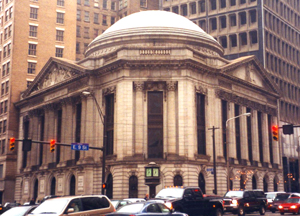- HubPages»
- Travel and Places»
- Visiting North America»
- United States»
- Ohio
Historic Cleveland Trust Company

As the City of Cleveland celebrated its centennial in 1896, there already existed a banking concern bearing the city’s name. The Cleveland Trust Company had begun several years before in rented office space near the center of town. But within less than a decade, the bank had grown so large, outgrowing a series of offices, that it undertook the construction of its own headquarters at East Ninth Street and Euclid Avenue, a prime intersection in then the nation’s 7th largest city.
The new structure’s architect, the renowned George B. Post, created an homage to riches, in the form of a muscular Italian Renaissance temple, with three floors of offices flanking a large and grand central banking hall. The new Cleveland Trust Company, with its fluted columns, marble walls and floors, bronze doors and grilles, and Corinthian detailing, both displayed and protected great wealth. But the structure’s true marvel was its massive skylit rotunda dome.
The great dome is a detail typical of Post’s work; he was respected and admired for his ability to cleanly span great voids in his buildings. The bank’s rotunda skylight, soaring 85 feet above the main banking floor, measures 61 feet across and is crowned by Tiffany-style glass panels in hues of blue, green and yellow. Elsewhere about the structure are thirteen murals by Francis David Millet, a painter whose works are displayed in several world-class museums, and a number of allegorical sculptures by Austrian Karl Bitter. You'll find more examples of unique art at rickzworld.
The Cleveland Trust Company (which originated the concept of ‘branch’ banks) continued to grow and expand through the early- to mid-1900s. By the middle 1960s, the bank realized the need for greater consolidation of its office space at its central location. It enlisted the architectural team of Marcel Breuer and Hamilton Smith to design an expanded headquarters. The resulting 29-story office tower, completed in 1971, now backs the southern flank of Post’s original temple structure. A second planned twin tower, to the east of the temple, was never constructed. Breuer’s single dark tall office slab is textured in a grillage of repeated precast window frames, and capped by a dark band of stone — punctured by a lone ‘keyhole’ on the tower’s southwest corner as a visual fillip.
The Cleveland Trust Company later changed its name to Ameritrust, and was eventually acquired by Society Bank, now known as Key Bank. Ownership of its original temple headquarters and tower fell to developer Richard E. Jacobs, and then to Cuyahoga County Commissioners for planned consolidation of county offices.







